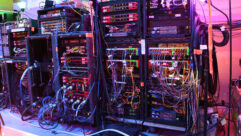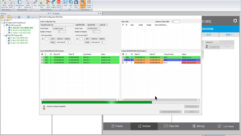
Focusrite RedNet Digital Audio Networking System Review
Jan 21, 2013 12:47 PM,
Reviewer: John McJunkin
A solid system for ingress, routing, and delivery of audio signals.

Focusrite RedNet system
Getting audio signals from one location to another is one of the tasks with which we professionals are charged, and while short runs of cabling continue to live in the analog domain, our long cable runs are moving nearly exclusively into the digital domain.
Focusrite has introduced a solution facilitating this advance: the RedNet networking system, which offers five rackmount devices and a PCIe card that enable the capture and distribution of audio signals. The RedNet 1 is an 8-channel A/D and D/A interface that handles conversion for the network. The RedNet 2 is a 16-channel version of the RedNet 1. The RedNet 3 is a 32-channel interface that introduces signals to the network that are already in the digital domain, specifically of AES, ADAT, and S/PDIF formats. The RedNet 4 is an 8-channel A/D interface with eight remotely controllable microphone preamplifiers. The RedNet 5 is a 32-channel interface that expressly bridges ProTools HD systems into the network. The RedNet PCIe card is an interface facilitating 128 channels of input and 128 channels of output for both Macintosh and Windows-based computers. The entire system supports sample rates of 44.1, 48, 88.2, 96, and 192kHz, and is based on Audinate Dante protocol.
I evaluated a RedNet system consisting of RedNet 1, RedNet 3, and RedNet 4 units, along with a RedNet PCIe card, facilitating interface with a Macintosh DAW. With the obvious exception of the PCIe card, all the RedNet interface units are 2RU enclosures. The front panel of the RedNet 1 converter includes a recessed area which features, from left to right, LEDs to indicate unit power, connection, sync lock, sample rate, tricolor level LEDs for each of the unit’s eight inputs and outputs, LEDs to indicate the unit’s analog reference level, and a power switch. The rear panel is very simple. From left to right is an IEC AC power inlet, Ethernet jack for connection to the Dante network, and two D25 connectors representing the unit’s eight inputs and outputs, respectively.
The recessed area of the RedNet 3’s front panel is very similar to that of the RedNet 1 but with the addition of LEDs indicating activity at the AES inputs and outputs. To the right of that are LEDs indicating activity on the unit’s ADAT inputs and outputs and five LEDs indicating with which clock the unit is synced: AES, ADAT, S/PDIF, word clock, or it’s own internal clock. From left to right across the RedNet 3’s rear panel, you’ll find an IEC AC power inlet, Ethernet port, BNC word clock in and out ports, RCA-type S/PDIF in and out ports, and eight TOSLINK input/output optical port pairs. Above the S/PDIF ports is a D25 connector, representing the unit’s AES inputs and outputs.
The RedNet 4’s front panel has the same power switch and power, network, and sample rate LEDs, but to the left of the recessed area are two 1/4in. DI inputs. To the right of the standard suite of LED indicators are individual green, yellow, and red LEDs indicating input level for each of the unit’s eight channels. To the right of these are three pushbuttons, a rotary encoder knob, and an OLED display. The first button advances through the three available input levels: mic, line, and DI. The second toggles 48V phantom power, and the third toggles in or out an 18dB/octave HPF with a -3dB point of 75Hz. The rotary encoder knob determines input gain. There are eight pushbuttons under the eight LED meters that determine to which of the eight mic preamps these controls are applied. The RedNet 4’s rear panel features, from left to right, an IEC AC power inlet, an Ethernet port, eight balanced XLR analog mic inputs, and a D25 connector representing eight line level inputs.
I installed a RedNet PCIe card into my Macintosh quad core (the system works with Windows platforms as well) and then installed the Audinate Dante Controller and RedNet Control applications. The Dante app is not necessary for simpler signal-routing scenarios, but necessary for more complex and non-standard routing. Additionally, the RedNet PCIe card is not necessary for system operation, but if RedNet units are hosted with Dante Virtual Soundcard software, latency is higher, and only 64 channels in each direction are supported. With my Mac turned off, I connected a network switch to my computer—both to the PCIe card’s Ethernet port and to my computer’s Ethernet port as well. Focusrite recommends a “managed” switch designed for 1,000Mbps (Gigabit) systems and with a power supply that connects directly to AC mains, as the “plug-top” power supplies typically associated with cheaper switches can actually create audible artifacts in the audio.
I connected the evaluation units to the switch, and then powered the switch on. I powered each of the RedNet units on, and once their front panels showed that they were connected and locked in sync, I powered up my Mac once again. I opened the Dante control application, which immediately “found” the connected units and displayed their names and presented a matrix facilitating connection between the inputs and outputs of the units. I then launched the RedNet control application, which upon “seeing” the three units, determined that the firmware of each was not the most recent revision and automatically downloaded and installed the most recent firmware in all three.
The RedNet application gave me complete control over all the parameters. And although the RedNet 4 features front-panel control of its mic preamplifiers, the rest of its user-adjustable parameters are accessible only via the computer application. The RedNet 1, 2, and 3 units have no front-panel controls whatsoever. It is very important to be aware of the computer system requirements so as to ensure that your computer will meet them.
The entire point of the RedNet system is the ingress, routing, and delivery of audio signals, and it accomplishes this goal exceedingly well. I was able to evaluate the system in both studio and live sound environments, and having the ability to route signals where they’re needed over Cat-6 cabling is vastly preferable to long analog cable runs or snakes for reasons already mentioned. The capacity to easily accept and then route signals in AES or ADAT (or even S/PDIF) formats is very useful. The addition of eight high-quality mic preamps in the RedNet 4 unit is also very welcome, particularly under remote control. I’ve always been a believer of avoiding long analog cable runs at mic level, so getting the preamps and converters close to the action and sending the signal along in the digital domain makes a lot of sense to me. The network performed well with my DAW, and the capacity for 128 channels of I/O is powerful and very appealing to me. The Focusrite converters sound very good, and hence become largely transparent to the process—you put your analog signal in one end and it emerges from the other sounding just like it did going in. The RedNet system is reasonably priced, sounds great, solves numerous difficulties created by analog cabling, and facilitates matrix routing possibilities that would be virtually impossible in the analog domain.
PRODUCT SUMMARY
Pros: Eliminates analog routing problems, quality sound, reasonably priced
Cons: Lack of front-panel control over system parameters
Applications: Any application requiring capture and digital distribution of audio signals
Price: All street prices: $1,999.99 (RedNet 1); $1,499.99 (RedNet 3); $2,499.99 (RedNet 4); $999.99 (RedNet PCIe)
SPECIFICATIONS
RedNet 1
Inputs:
Frequency response: 20Hz-20kHz ±0.05dB
THD+N: < 0.001% unweighted; -1 dBFS input, 20Hz-22kHz
Dynamic range: 119dB ‘A’-weighted (-60dBFS method)
Converter dynamic range: 120dB
Signal-to-noise ratio: 119dB ‘A’-weighted; 20Hz-20kHz
Outputs:
Frequency response: 20Hz-20kHz ±0.15dB
THD+N: < 0.001% unweighted; -1 dBFS input, 20Hz-22kHz
Dynamic Range: 119dB ‘A’-weighted (-60 dBFS method)
Converter dynamic range: 120dB
Signal-to-noise ratio: 119dB ‘A’-weighted; 20Hz-20kHz
Crosstalk:
Input or Output to Input: <-90dB (all other channels at 0dBFS)
Input or Output to Output:<-100dB (all other channels at 0dBFS)
RedNet 3
AES/EBU Input Sample Rate Converters:
Input sample rate range: 32 to 216kHz
Gain error: -0.3dB
Dynamic Range: > 138dB (-60 dBFS method)
THD+N: < -130dB (0.00003%); 0dBFS input
RedNet 4
Microphone Inputs:
Gain range: 0dB; 8 to 63dB in 1dB steps
Type: Classic ISA-based, electronically balanced, Zin = 2.4 kΩ
Max. input level: +16 ±0.5dB; min. gain for 0dBFS, Rs=150Ω, pad out
Min. input level: -47 ±0.5dB; max. gain for 0dBFS, Rs=150Ω, pad out
Frequency response: 20Hz–55kHz±0.1dB(-3dB@80kHz,fs =192kHz); Rs =150Ω
THD+N: < 0.0007% @ -1dBFS; +15dBu input, Rs = 150Ω, 20Hz – 22 kHz
Noise: EIN-128dB; 60dBgain, Rs =150Ω, 20Hz–22kHz
Phantom power: 48V, independently switchable per-channel
Signal-to-noise ratio: 119dB ‘A’-weighted; Rs = 150Ω
Line Inputs
Gain range: -12 to 42dB in 1dB steps
Max. input level: +24 ±0.5dB; min. gain for 0dBFS
Min. input level: -30 ±0.5dB; max. gain for 0dBFS
Frequency response: 20Hz-20kHz ±0.1dB
THD+N: < 0.003% @ -1 dBFS; +23dBu input, min. gain, 20Hz-22kHz
Signal-to-noise ratio: 117dB ‘A’-weighted
Instrument Inputs (Inputs 1 & 2 only)
Gain range: +14 to 68dB in 1dB steps
Max. input level: +10 ±0.5dB; min. gain for 0dBFS
Min. input level: -44 ±0.5dB; max. gain for 0dBFS, pad out
Frequency response: 20Hz-20 kHz ±0.1dB
THD+N: < 0.001% @ -1dBFS; +9dBu input, min.gain, 20Hz-22kHz
Signal-to-noise ratio: 112dB ‘A’-weighted
John McJunkin is the principal of Avalon Podcasting in Chandler, Ariz., and produces and co-hosts a top-rated morning radio talk show in Phoenix. He has consulted in the development of studios and installations and provides high-quality podcast and voice production services.









